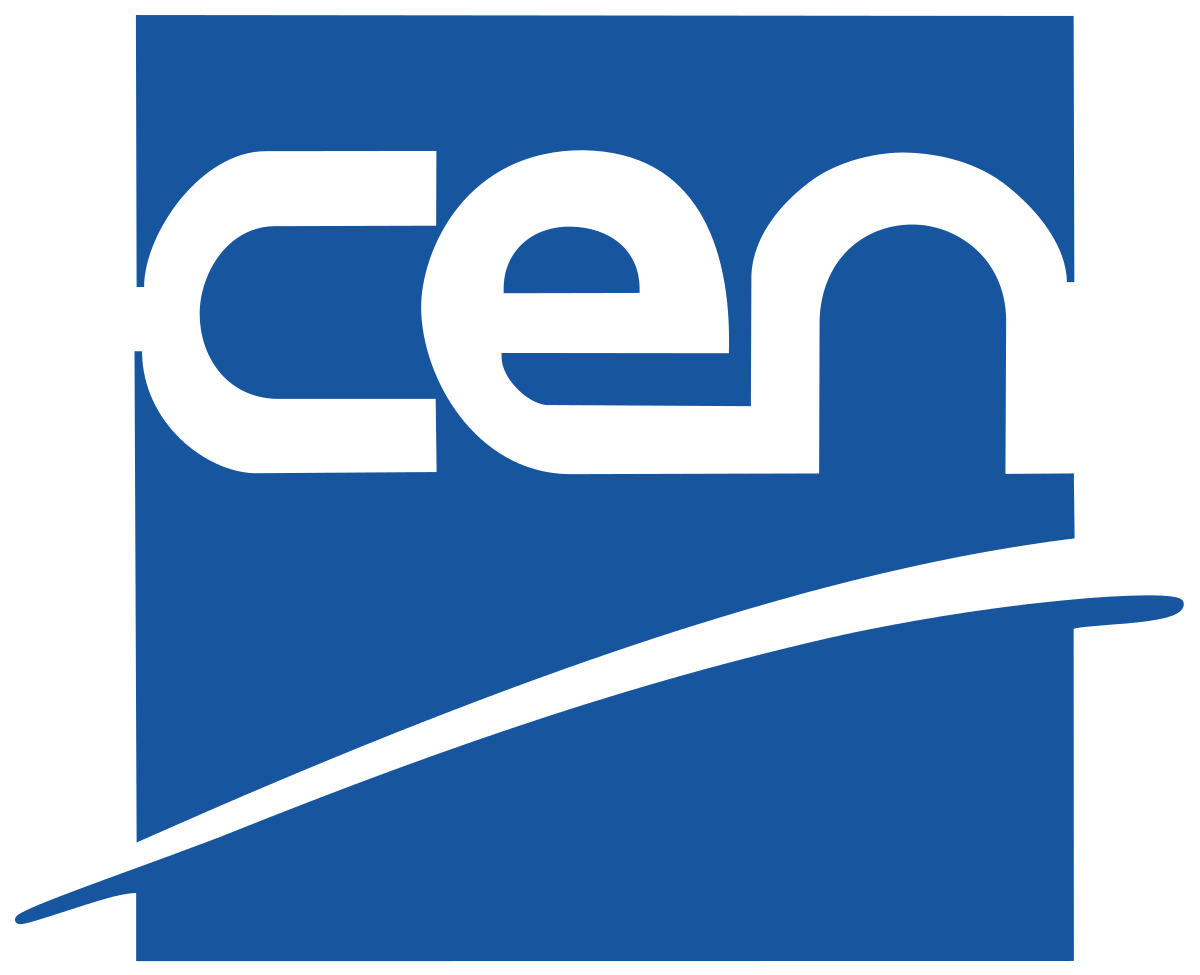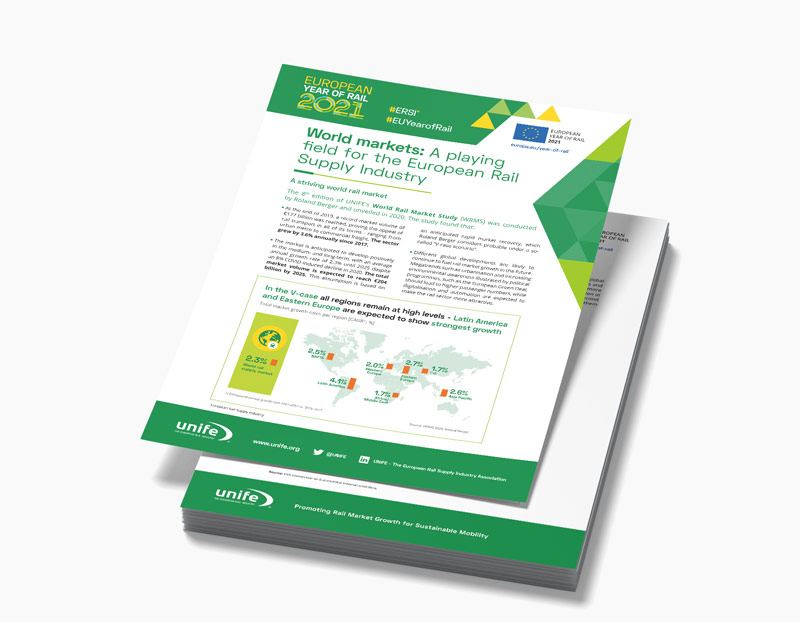Interactive Factsheet
World markets: A playing field for the European Rail Supply Industry
A striving world rail market
The 8th edition of UNIFE’s World Rail Market Study (WRMS) was conducted by Roland Berger and unveiled in 2020. The study found that:
At the end of 2019, a record market volume of €177 billion was reached, proving the appeal of rail transport in all of its forms – ranging from urban metro to commercial freight. The sector grew by 3.6% annually since 2017.
The market is anticipated to develop positively in the medium- and long-term, with an average annual growth rate of 2.3% until 2025 despite an 8% COVID-induced decline in 2020. The total market volume is expected to reach €204 billion by 2025. This assumption is based on an anticipated rapid market recovery, which Roland Berger considers probable under a so-called “V-case scenario”.
Different global developments are likely to continue to fuel rail market growth in the future. Megatrends such as urbanisation and increasing environmental awareness illustrated by political programmes, such as the European Green Deal, should lead to higher passenger numbers, while digitalisation and automation are expected to make the rail sector more attractive.
In the V-case all regions remain at high levels – Latin America and Eastern Europe are expected to show strongest growth
Total market growth per region [CAGR1, %]
Source: WRMS 2020, Roland Berger
The European Rail Supply Industry: A world leader
The European rail supply industry has a long been a worldwide leader in the field and an important exporting industry. It supplies approximately half of the global demand for rail supplies and over 80% of the European demand for rail products. Many of the most cutting-edge innovations in the field, from energy-efficiency products to digitalisation solutions, are designed and manufactured by European companies.
The European rail supply industry is a global leader in exports, particularly of locomotives and rolling stock – for which value has grown by more than four times since 2000, to reach €4,8 billion in 2017. China and the United States are in second and third positions, respectively, each of them generating less than half of EU exports.
The increase of the market shares of China, the USA, and Japan contributed to the downtrend for EU exports between 2014 and 2015.
RSI Exports2, locomotives and rolling stock, EUR million
2 Extra-EU values estimated based on estimation from COMEXT data.
Consumption, locomotives and rolling stock, main global players, EUR million
Source: VVA elaboration on Euromonitor International data.
ERTMS, from European rail traffic management technology to global
standard: a European exports success story
The European Rail Traffic Management System (ERTMS) is a technology was first conceived by Europe’s rail transport industry experts more than 20 years ago to make cross-border rail traffic throughout the continent much smoother, safer, faster and more competitive.
Over the past 10 years, the signaling system has become, de facto, a global standard that is continuously seeing new countries investing in it despite being originally conceived as only a European standard. The number of vehicles equipped (or to be equipped) globally has increased by 144% between 2010 and 2020.
During the same period, the number of ERTMS-contracted tracks (in kilometers) in the world rose by 164% (source: UNIFE).
According to UNIFE’s internal statistics, today, ERTMS is deployed across 100,000 km of contracted track in more than 51 countries and is equipped, or slated to be, on more than 16,000 vehicles. 49% of ERTMS trackside investments are located outside Europe and 31% of investments are dedicated for on-board deployment (see Global ERTMS Deployment Map below).
ERTMS is deployed across 100,000 km of contracted track in more than 51 countries
Among the top extra-EU countries where ERTMS-based products are more successfully exported, China, Turkey and Saudi Arabia are first in line with regards to the trackside implementation with respectively 20.870, 5.009 and 4.519 Km.
For on-board investments, China, Taiwan and Australia respectively 1.045, 940 and 777 vehicles are equipped or are planned to be equipped, with ERTMS (see further details in the diagrams below).
Contracted vehicles outside Europe
(ETCS L1 &/or L2)
Contracted tracks (km) outside Europe
(ETCS L1 &/or L2)
The increasing need to level the playing field
Decreasing world rail market accessibility
Despite these positive developments on world rail markets and its competitive edge, the European rail supply industry faces an increasingly uneven playing field when it comes to public procurement and investment.
Several countries tend to close or restrict access to their markets, through an array of barriers (ex. local content requirements, lack of transparency or discrimination in procurement procedures, etc.).
Some do so to support domestic champions, others to create local jobs, but the result is an overall decrease in world rail market accessibility, from 72,6% in 2009 to 61,6% in 2020. This stands in sharp contrast with a transparent and open European market.
Evolution of world rail market accessibility
Source: WRMS, Roland Berger
In some cases, such as in China’s rail market, the decline has been particularly strong. In that market, there has been observable accessibility decrease of over 70% between 2009 and 2019.
Given the size of this market, it also creates a significant advantage (i.e., economies of scale) for domestic players looking to export to international markets.
China market accessibility
Source: WRMS, Roland Berger
Unfair competition on the rise
In markets that are open, and especially in emerging ones, European rail suppliers are facing fierce competition from state-owned companies benefiting from strong government support which gives them the ability to underbid competitors. This is a worrying trend that can also be increasingly observed in Europe.
The phenomenon creates a strong risk for the growth of the European rail supply industry and its ability to thrive on both European and international markets.
While the European rail supply industry believes in free trade, competition needs to be fair. This principle should be underpinned by the right policies and tools.

UNIFE activities to support the global leadership of the European Rail Supply Industry
An EU trade policy that actively promotes a level-playing field
UNIFE acts on trade dossiers and negotiations where the interests of the European rail supply industry are at stake. This usually concerns:
- important legislative instruments that in part compose the EU toolbox, such as the International Procurement Instrument (IPI), investment screening and, more recently, the European Commission’s draft Regulation to address distortions caused by foreign subsidies in the EU market
- prominent markets where trade negotiations between the EU and its partners are ongoing or foreseen, and where barriers to enter the market exist (e.g., EU-China Comprehensive Agreement on Investment)
- plurilateral or multilateral agreements impacting the EU rail industry (e.g., OECD export credits, WTO Agreement on Government Procurement, etc.)
UNIFE’s advocacy on these important topics is also achieved through AEGIS Europe, a coalition of European manufacturing associations committed to free and fair international trade.
Bilateral cooperation to promote industry standards outside the EU
UNIFE acts as a catalyst for fair global trade by developing bilateral relations with its foreign counterparts to help disseminate European expertise on a number of key topics such as interoperability, safety, signalling (ERTMS) and more. It also works to maintain the leadership of the European rail industry worldwide, for instance, by organising and participating in many events with these partners for the benefit of its members.
Over the years, UNIFE has developed several long-lasting partnerships:
UNIFE’s Bilateral cooperation
UNIFE’s view on international standardisation
Technical standards enable interoperability of products and technologies by defining technical specifications. Their application remains voluntary unless required by legislation or contractual agreements. For the European rail supply industry, standardisation is key to improving quality, reducing cost, and increasing competitiveness.
Today, most standards for the railway sector are European Norms (EN), but, increasingly, international standardisation activity at the at ISO and IEC are gaining importance: On one hand, international standardisation activity outside the railway standardisation committees – notably, in the digital area – is becoming more relevant for the railway sector. On the other hand, many new work items in the traditional railway domain are being launched at the international level, and mores so at the initiative of non-European countries.
Coordination is ensured via agreements between the European and International Standardisation Organizations allowing for migration of standards and a parallel approval process. However, since only active participation of European experts in the standardisation working groups can ensure that the needs of European industry are reflected, the EU must now recognise the growing role of international standardisation activities for the railway sector and the strategic implications this has for the European rail business.
UNIFE calls for a better coordination and awareness at the European Standardisation bodies and their technical committees of international standardisation initiatives relevant to the rail sector to ensure Europe’s future leadership in railway standardisation. An increased use of digital tools in the standard making process will improve processes and reduce costs for companies active in standardisation.
Rail Standardisation in Europe

CEN TC256

CENELEC TC9X
International Rail Standardisation

ISO/TC 269

